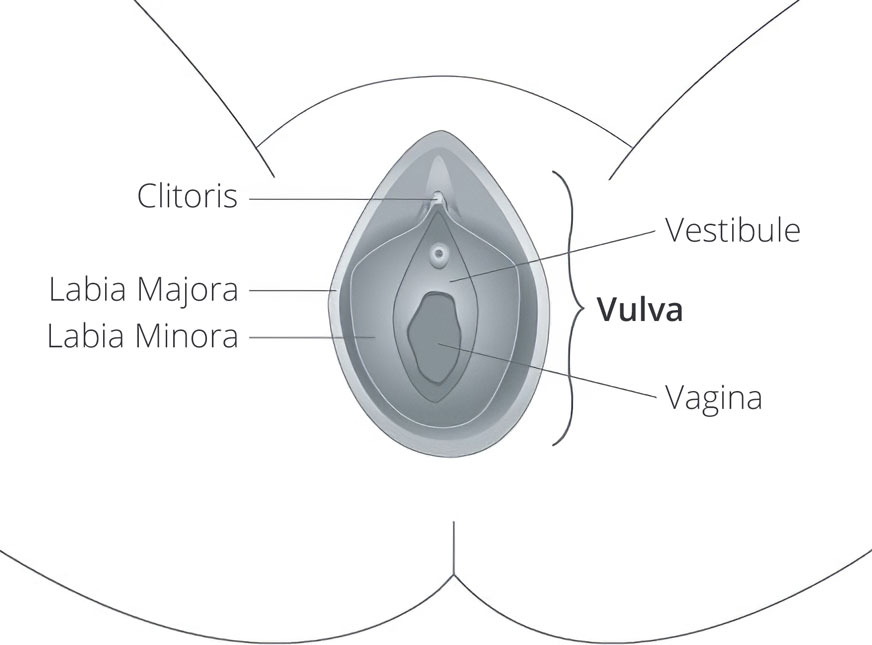
Pain associated with the vulvar vestibule
Vestibulodynia is a specific type of pain that often gets bundled into the diagnosis of “vulvodynia” – pelvic pain. But it is important that Vestibulodynia be diagnosed properly so that you get treated appropriately. Vestibulodynia is pain in the vulvar vestibule, the small area of tissue just prior to the vaginal entrance (see diagram below). There are different types of Vestibulodynia and it is often difficult for a non-specialist to determine what is contributing to the pain. It is critical that your practitioner be knowledgeable enough to differentiate between “types” of Vestibulodynia in order to determine the treatment that will work best for you. The good news is that once an accurate determination has been made, Vestibulodynia is treatable and you do not have to live with the pain.
What is Provoked Vestibulodynia (PVD)?
The most common form of vestibulodynia is Provoked Vestivulodynia (PVD), which describes pain to the vulvar vestibule in response to some form of contact. Generally women who have PVD do not experience pain unless the vestibule is touched (ie. Tampon, intercourse), and usually there is no pain in the vagina.
PVD can be primary or secondary. Primary PVD is vestibular pain that occurs the first time a woman attempts any type of vaginal penetration, like inserting a tampon or trying to have intercourse. Secondary PVD is more common and involves pain that develops months or even years after a woman has had pain free vaginal penetration.
What are causes of Provoked Vestibulodynia (PVD)?
There is a long list of things that can result in PVD. Knowing what is specifically causing your vulvodynia will help make a determination on how to fix the problem. The most common types of PVD are:
Hormonally Mediated Vestibulodynia is pain that occurs because of a hormone imbalance or deficiency. This is very common result of long term birth control pill use, menopause, breast feeding, and medications for endometriosis or endometrial cancer
Congenital Neuroprolifertive Vestibulodynia is pain which is caused by too many nerve endings in the introitus. This condition will have always been present because women are born with it. Usually it is noticed first at the time of first attempt to insert a tampon or first attempt at intercourse. Patients with this type of Vestibulodynia have never had pain free intercourse.
Acquired Neuroproliferative Vestibulodynia is pain that begins as a severe allergic reaction to a topical medication or pain that is due to a severe yeast infection. Women with a history of having very sensitive skin or many allergic reactions usually fall into this category.
Hypertonic Pelvic Floor Vestibulodynia is pain that starts in response to the muscles of the pelvic floor remaining in a chronic high tension state. The high tone in the muscles decreases blood flow and oxygen to the vaginal entrance, thus creating a hypersensitive vestibule.
While these are the most common causes of vestibulodyina, additional causes might include:
- Genetic factors that make the vulva respond poorly to chronic inflammation
- Hypersensitivy to chronic yeast infections
- Sexual Trauma
- Frequent antibiotics
What are treatments for Hormonally Mediated Vestibulodynia?
One of the first changes made when a patient is diagnosed with hormonally mediated Vestibulodynia is to stop birth control pills. Birth control pills suppress the ovaries and reduce production of estrogen and testosterone, two hormones essential in keeping the vestibule healthy. Birth control pills also increase a protein called SHBG which further inactivates these hormones. Discontinuing the birth control pills will give the women’s body a chance to start natural production of estrogen and testosterone. It can take several months before these hormones are back to normal again.
Often patients will also be treated with topical application of estrogen cream, or other forms of estrogen and testosterone gel or cream. These products are available only by prescription and some have to be compounded by a specialty pharmacy.
What are treatments for Neuroproliferative Vestibulodynia?
There is not one gold standard of treatment for this type of vestibulodynia.
Sometimes physicians will give patients topical anesthetics. These medications numb the receptors in the vestibule and block the feelings of pain a patient may have. This treatment is not very popular as many patients do not feel that the anesthetics give them adequate relief and often they block any pleasurable feelings the patient may have. An example would be the use of lidocaine topically before intercourse.
Other treatments may include specific anti-depressants and anti-seizure medications that can be compounded into a cream that can be applied to the vestibule. While some of these medications may give some relief, they are not widely effective.
Capsaican Cream — a cream made from the substance that gives chili peppers its heat is also used. It is applied 20 minutes every night for 6-12 weeks. It causes burning upon application. It decreases Substance P which can cause less vestibular pain. This treatment can be effective, however, if you stop using this cream the nerve endings will recharge and pain will begin again.
In many cases surgery, a vulvar vestibulectomy with vaginal advancement, is considered the final option for treatment. The surgery involves removing a postage stamp size piece of tissue from the vestibule thereby decreasing the number of nerve endings. Recuperation time is usually 6-8 weeks. Cost is roughly 20 thousand dollars.
We, at Maze, are very excited to offer a new alternative to vulvar vestibulectomy. A low-level laser treatment, which involves 12 -18 painless laser treatments may resolve the problem for 80% of patients who have been told they need surgery. As far as we know, we are the only ones offering this innovative new treatment in the US. Contact us today to schedule a free, in-office consultation to see if laser therapy is right for you.
What are treatments for Hypertonic Pelvic Floor Dysfunction?
This pain is perhaps the easiest to treat. Generally treatment involves vaginal dilation therapy – progressive insertion of vaginal dilators to help stretch and relax the muscles of the pelvic floor.
Often patients may be referred to pelvic floor physical therapist who will work on trigger points, lengthening and loosening the muscles.
We might prescribe compounded muscle relaxant suppositories inserted nightly into the vagina or rectum to help relax the muscles of the pelvic floor.
In some cases, medical injections will help stop the tightening of the pelvic floor muscles.
Is there an alternative to Vestibulectomy?
Maze Women’s Health is using new innovative low level laser therapy treatment which is proving to have significantly positive results. A small study has shown this treatment to be 80% effective for Neuroproliferative Vestibulodynia. A low level laser probe is applied directly to the painful areas, treatments are twice weekly for 3 to 8 weeks. The procedure is painless. Contact us today to schedule a free, in-office consultation to see if laser therapy is right for you.

